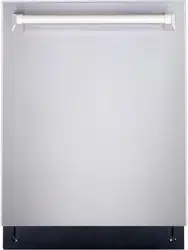Loading ...
Loading ...
Loading ...

12 13
2 Add rinse aid until the liquid touches the indicated fill level. Do not overfill since this can cause over-sudsing. Wipe up
any spills with a damp cloth. The dispenser holds enough for 35 to 140 washes, depending on the dial setting.
3 Replace the cap and turn it 1/4 turn clockwise.
Factors affecting performance
Using rinse aid
Rinse aid greatly improves drying and reduces water spots and filming. Without rinse aid, your dishes and dishwasher
interior will have excessive moisture. In addition, the heated dry option will not perform as well without rinse aid. The rinse
aid dispenser, located next to the detergent cup, automatically releases a measured amount of rinse aid during the last
rinse.
If spotting and poor drying is a problem, increase the amount of rinse aid dispensed by rotating the dial to a higher
number. The dial is located under the dispenser cap.
If the rinse aid is low, the rinse aid light turns on at the beginning and end of the cycle indicating that it is time to refill.
Refer to "Filling the rinse aid dispenser" on page 11.
Water temperature
Hot water is required for optimum dish washing and drying results. Water entering the dishwasher should be at least
120° F (49° C) to achieve satisfactory results.
To check the water temperature entering the dishwasher:
1 Turn on the hot water faucet near the dishwasher and let it run for several minutes.
2 Hold a thermometer (a candy or meat thermometer will work) in the water stream to check the temperature. If the
temperature is below 120° F (49° C), have a qualified person raise the hot water heater thermostat setting.
Heat dry function
The heat dry function, when used with a rinse aid, enhances drying performance. If you do not choose the heat dry
function, items in your load that will not be completely dry at the end of the cycle.
Water pressure
For optimum performance, the hot water supply line for your dishwasher must provide water pressure of at least 20 psi
(138 kPa) and not more than 120 psi (828 kPa). You may experience low water pressure during high-demand periods, such
as when laundry or showers are in use while you are washing the dishes. To eliminate this problem, wait until hot water
demand is reduced before starting the dishwasher.
Important: To make sure that the water entering the dishwasher is hot, run hot water from the nearest hot water faucet to clear cool water
from the pipe before starting the cycle.
Maintaining your dishwasher
Cleaning the stainless steel panel
Clean the stainless steel door and handle regularly with a soft cloth and standard household cleaner to remove the debris.
Cleaning the control panel
Clean the control panel gently with a soft, lightly dampened cloth.
Cleaning the stainless steel inner door and tub
The tub is made of stainless steel. It will not rust or corrode, even if the dishwasher should be scratched or dented.
Clean the spots on the steel inner door and tub with a damp non-abrasive cloth.
Cleaning the filters
The filters are designed to collect debris and need to be cleaned monthly to maximize wash performance.
1 Remove the bottom rack.
2 Rotate the cylinder filter, then lift it out.
3 Lift the fine filter from the bottom of the tub.
CAUTION: TO AVOID BURN INJURY: Allow the heating element to cool before attempting to clean the interior of your dishwasher.
CAUTION: Do not use appliance wax, polish, bleach, or products containing chlorine to clean the stainless steel door.
Loading ...
Loading ...
Loading ...
